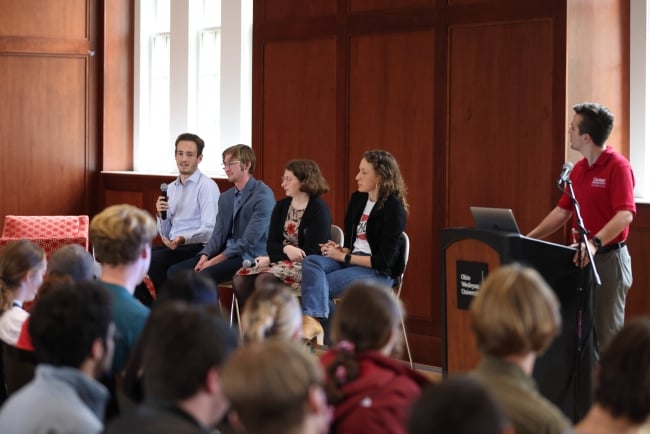You have /5 articles left.
Sign up for a free account or log in.

Students talk on a panel at Ohio Wesleyan University's Connection Conference, focused on careers, internships and more.
Paul Vernon/Ohio Wesleyan University
Ohio Wesleyan University’s first-to-second-year retention rate tops 84 percent this academic year, nearly three percentage points higher than the year prior and six percentage points higher than the year before that. Among first-generation students, in particular, retention is up just about 10 percentage points. Among Pell-eligible students, it’s up seven.
Retention among second- to third-year students increased seven percentage points over last year’s cohort, as well, to some 94 percent.
The university hasn’t seen numbers like this since 2009. What’s behind them? Ohio Wesleyan officials attribute the progress to an “all-hands-on-deck” initiative launched two years ago aimed at making student success everyone’s business.
Dwayne K. Todd, vice president for student engagement and success and dean of students, says the university was underperforming relative to peer institutions on retention leading up to 2021. He and colleagues “believed we could do better at it—and that there were some opportunities that were unrealized for us.”
Todd recalls a mutual understanding that progress would depend on avoiding “one of those realities of higher ed—that sometimes people do really good work, but they do it in a disconnected fashion.”
Beyond coordinating efforts, particularly among student affairs and academic affairs, Todd says he and colleagues knew they’d have to target all three legs of the student success stool: financial, academic and social.
“If one of those legs is wobbly for a student, they might not be able to get through,” he says. “So we’ve tried to look at this as a holistic approach to retention. How do we help students be able to afford this experience? How do we make sure that they have all the support they need academically, and that they are advised well, feeling like they are on track and making progress toward their degree? And then, how do we ensure that the social experience, or the community experience, is as solid as it can be for each student?”
One key change was appointing a dean of student success, who works with the university’s enrollment and student success divisions and reaches out to students at risk of not persisting. Todd says this work is targeted to individual students’ needs, including connecting them to available resources. In some cases, the university awards emergency grants from donor funds to students struggling to pay off an account balance so that they can register for the next semester.
Another change was improving housing facilities for first-year students. Nearly all first-year students are now housed in a single renovated building designed to “create a stronger sense of cohort among them and to generate engagement.” Resident advisers trained to work with the nearly 400 first-year occupants deliver a residential curriculum.
Ohio Wesleyan also attributes its gains to a series of other initiatives (some of which existed in some form prior to 2021), including:
- Moving the Needle: Launched in 2021, this effort created campuswide committees to brainstorm and adopt student success solutions. Current committee work centers on academic support, the business of being a student, the first-year experience and holistic student advising. (Related note: Ohio Wesleyan hired its inaugural director of holistic advising earlier this year.)
- Bridge program: Relaunched in 2021, the three-week residential experience targeting first-year students has already boosted retention: alumni have a 95 percent retention rate. Students now earn academic credit for their efforts.
- Bishop ACCESS: The fee-based program provides one-on-one academic coaching for students with executive function challenges, including those with learning disabilities and mental health issues.
- Camp Oh-Wooo: All incoming students participate in an off-campus, community-building adventure after moving in but prior to the start of classes.
- First-year seminar: All new students complete a first-year seminar course called How to Change Your World, focused on charting the course of their academic journey, building relationships and tackling a specific global challenge. The course’s current theme is “Mobility, Migration and Belonging.”
- Bishop Elevate: This program, new this year, offers support for first-generation students, who make up one-fifth of all students. The university’s newly appointed director of first-generation success oversees operations.
- OWU Connection: The university’s signature experience, which is integrated into the curriculum, connects classroom learning with outside experiences including internships, research, travel and creative projects.
Provost Karlyn Crowley underscores that Ohio Wesleyan is getting results from doing not just one thing but many, as part of a coordinated effort to unlock student success.
“We are asking, ‘What is getting in the way of student success?’ And then we clear it,” she says. It’s a “whole-campus effort to see what is not student-centered and make it so.”
What are you doing to boost retention on your campus? Let us know.





